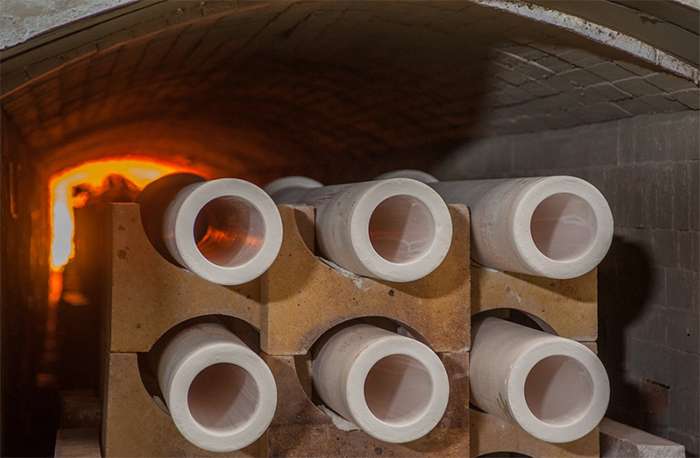Refractory or refractory materials
Refractories and refractory materials are called inorganic as well as non-metallic materials that at very high temperatures, their chemical and physical properties are still constant and do not disappear. And resistant, magnesium carbonate or carbon-containing minerals are among the materials from which part of the refractory (refractory material) is made, it may be interesting to know that refractories are resistant above 1500 ° C.
Refractory materials
The great variety of thermal applications in the industry has led to the creation of a large number and variety of refractory materials. In other words, most of these refractory materials (refractory) are specially designed to meet the needs and desires of a process that is specially produced for them. Each type of refractory material has properties that these properties follow from the materials used during construction and the beginning of the work, as well as the method in which they are made.
Advantage of refractory (refractory materials)
Refractories (refractory materials) can withstand high pressure, high temperature, high resistance, abrasion resistance and heat retention are some of the advantages of refractories or refractories.
Main materials of refractories Main materials of refractories
In the following discussion of refractories (refractory materials), we have a classification of refractories based on their main constituents, which we will briefly describe the main materials of refractories (refractories):
| magnesia | graffiti | selisi |
| dolomite | chromite | silimanite |
| clay fire eater | bauxite | forsterity |
| silica | alumina |
description of the main materials of some refractory materials (refractory materials):
the main materials of chromite refracte: the main materials of refractices are chromite minerals and also aluminum oxide, silicon, magnesium and calcium are found in its composition.
magnesite refracce: one of the main materials of magnesite refracets, we can mention magnesite, which also has a high melting temperature.
dolomite refracte main material: materials whose foundation is from a rock called dolomite and has little resistance.
the main materials of alumina refracsis: the combination of bauxite and fire-eating clay as well as endalozite and silymanite as well as cyanite are used, i.e. all of these are the main materials of alumina refracsis.
the main material of oxide refracsis: one of the most important types of this oxide refracte is kenya’s refracte, which is resistance to 2500 degrees and has a higher price than other refractes, and is also found and used more limitedly.
graphite refracte main material: the main materials are clay and graphite, which also have high thermal resistance.
refractory properties (refractory materials) and properties
- high heat resistance
- abrasion resistance
- reggae properties
- thermal shock resistance
refracte raw materials
refractory raw materials and refractory raw materials both convey the same meaning and meaning.
refractes are categorized based on the main materials used in it and the method of production.
what was refractory raw material? or what were the ingredients of refracte?
Refractory raw materials are based on 6 main oxides: AL2O3, Mgo, Cao, Cr2O3, ZrO2, Sio2 and derivatives, as well as one of the most important raw materials of refractory refractory that is most widely used
نسوز آلومینیوم سیلیکات که از AL2O3 و SiO2 بوجود می آید و مواد اولیه نسوز آلومینیوم سیلیکات همانطور که در بخش های قبلی نیز گفته شد از رس آتشخوار، بوکسیت، سیلیمانیت و کیانیت و آندالوزیت می باشد.
مواد اولیه نسوز سیلیسی که حاوی آلومین Al2O3 و تیتانیم TiO2 و همچنین اکسید آهن FeO3 و اکسید کلسیم CaO می باشد و از مواد اولیه این نسوزها می توان به کوارتز، کوارتزیت و ماسه سنگ سیلیسی اشاره کنیم.
refractory brick
refractory brick is a type of brick that is produced from porcelain and refractory soils and is dense and delicate with molecular structure. the base materials are refractory bricks, very special minerals and mineral shells, which are refractory. و نحوه تولید این نوع آجر به این صورت است که، ابتدا سنگ ها را آسیاب کرده و سپس به خاک نرم تبدیل می شود و پس از 3 روز پخت در کوره در دمای بالای ۱۵۰۰ درجه سانتیگراد ساخته می شود. as the name implies, this brick with its high thermal resistance is widely used in furnaces and cauldrons and industrial insulation. of course, its typical type is also used today in brick facades of buildings.
آجر نسوز نیز از انواع مصالح ساختمانی می باشد که به طور معمول برای نما ساختمان ها و بناها مورد استفاده قرار می گیرد. due to the new style of building, refractory bricks are used as building facades. مواد اولیه برای ساخت آجر نسوز خاک نسوز می باشد و به طور کلی این نوع از خاک رس در معادن کشور یافت می شوند زیرا دارای مرغوبیت بالایی میباشد. refractory brick has different sizes, the most common size is 7*32 – 5.5*26 – 20*10.



